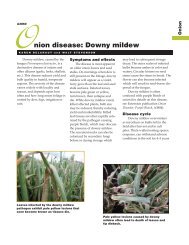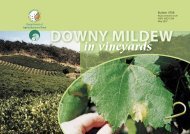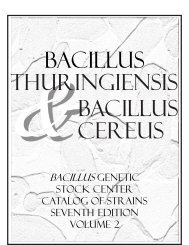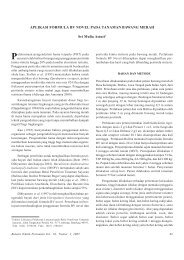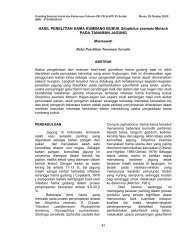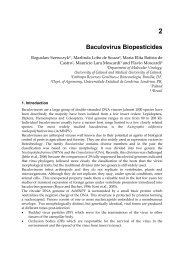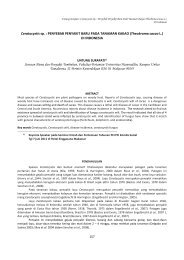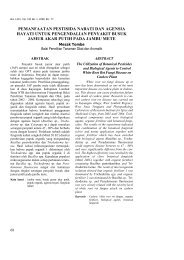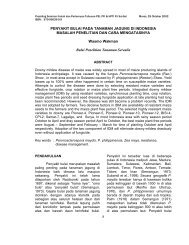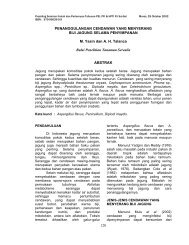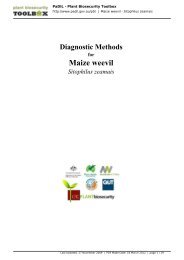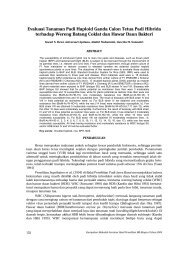Efficiency of the entomopathogenic fungus Verticillium lecanii in the ...
Efficiency of the entomopathogenic fungus Verticillium lecanii in the ...
Efficiency of the entomopathogenic fungus Verticillium lecanii in the ...
You also want an ePaper? Increase the reach of your titles
YUMPU automatically turns print PDFs into web optimized ePapers that Google loves.
% <strong>of</strong> germ<strong>in</strong>ationBouhous and Larous 24371008060402001 2 3 4 5 6 8 10 11 12Time (hours)Figure 3. V. lecani spore germ<strong>in</strong>ation at 24°C and H.R=100%.dur<strong>in</strong>g 12 h (Drummond, 1987; Hall, 1976).Insect cultureTwo young bean plantations <strong>in</strong> <strong>the</strong> stage <strong>of</strong> <strong>the</strong> apparition <strong>of</strong> <strong>the</strong>two first leaves were <strong>in</strong>fected by several aleurodes dur<strong>in</strong>g 24 h<strong>in</strong> an <strong>in</strong>sect cage (60x60x60 cm). Aleyrodes were elim<strong>in</strong>atedafter sett<strong>in</strong>g <strong>the</strong>ir eggs on <strong>the</strong> lower face <strong>of</strong> <strong>the</strong> leaves, so that<strong>the</strong> obta<strong>in</strong>ed population <strong>of</strong> eggs, larvae and adults will behomogenous.Eggs and stage II larvae treatmentLeaves were observed under a magnify<strong>in</strong>g glass to localize <strong>the</strong><strong>in</strong>fected zones. 7 mm diameter discs <strong>of</strong> leaves were cut, eachdisc conta<strong>in</strong>s at least 2 to 20 eggs or stage II larvae. Discs wereimmersed dur<strong>in</strong>g 10 s <strong>in</strong> a freshly prepared <strong>fungus</strong> sporesuspension, and <strong>the</strong>n 10 <strong>of</strong> <strong>the</strong>se discs were placed on <strong>the</strong>surface <strong>of</strong> <strong>the</strong> agar 1.5%. The Experiment was carried out <strong>in</strong>triplicate. Controls were provided for each experiment.Incubations were done <strong>in</strong> desiccators at 20°C under a relativehumidity <strong>of</strong> 100% with a photoperiod <strong>of</strong> 16 h per 24 h. Mortalitypercentage was determ<strong>in</strong>ed from <strong>the</strong> 5th day <strong>of</strong> contact. LD50were calculated accord<strong>in</strong>g to <strong>the</strong> method <strong>of</strong> Probit (Bliss, 1935;Drummond et al., 1987).Adults treatmentAdults <strong>of</strong> <strong>the</strong> same age were captured after cool<strong>in</strong>g dur<strong>in</strong>g 5m<strong>in</strong> <strong>in</strong> <strong>the</strong> refrigerator. They were <strong>the</strong>n recovered anddistributed <strong>in</strong> tubes to get 30 <strong>in</strong>sects per tube. They werecooled aga<strong>in</strong> and put quickly <strong>in</strong> contact with a 7 days <strong>fungus</strong>culture. After 30 m<strong>in</strong> <strong>of</strong> contact, spore <strong>in</strong>fected adults werereleased <strong>in</strong> <strong>the</strong> desiccators each conta<strong>in</strong><strong>in</strong>g a host plant.Desiccators were adjusted to a relative humidity <strong>of</strong> 100% at20°C and exposed to light dur<strong>in</strong>g 16 h per 24 h <strong>in</strong> a phytotron<strong>in</strong>cubator (Drummond et al., 1987; Ekbom, 1979).Effect <strong>of</strong> relative humidity (RH)Eggs and Stage II larvae were treated with a dose <strong>of</strong> about1.5x10 7 spores/ml. The whole (eggs/ larvae/ spores) were<strong>in</strong>cubated at 20°C, first at 100% RH dur<strong>in</strong>g 16 h and <strong>the</strong>n at70% RH dur<strong>in</strong>g 4, 8, 12, 20 and 96 h. It was f<strong>in</strong>ally put at a RH<strong>of</strong> 100% dur<strong>in</strong>g 7 days compared to control. For each case, <strong>the</strong>mortality rate was estimated after 7 days.RESULTSSpecies identificationSamples <strong>of</strong> <strong>in</strong>fected leaves with different larval stages<strong>of</strong> <strong>the</strong> aleurode were collected from two agriculturalregions (El Kennar and El Aouana) (Figure 2). Slideswere prepared and exam<strong>in</strong>ed by <strong>the</strong> opticalmicroscope (Colles, 1958). Identification was doneaccord<strong>in</strong>g to Mart<strong>in</strong> (1987). Leaves samples analysisallowed not<strong>in</strong>g <strong>the</strong> total predom<strong>in</strong>ance <strong>of</strong> T.vaporariorum species. The species exists ongreenhouse cultures and even on o<strong>the</strong>r outsideadventitious plants.Spore germ<strong>in</strong>ationThe spore germ<strong>in</strong>ation starts s<strong>in</strong>ce <strong>the</strong> first hour andreaches a rate <strong>of</strong> 65% after 9 h and 92% after 12 h <strong>of</strong><strong>in</strong>cubation (Figures 3 and 4).Effect <strong>of</strong> fungal spore concentration on differentdevelopment stages <strong>of</strong> T. vaporariorumEffect on eggsThe percentages <strong>of</strong> mortality after treatment showedan <strong>in</strong>crease <strong>of</strong> about 6.9, 14 and 61.8% for <strong>the</strong> threedoses and contact times used. LD 50 were: 4.2x10 7spores/ml <strong>in</strong> day 5; 2.1x10 7 spores/ml <strong>in</strong> day 6 and0.59x10 7 spores /ml <strong>in</strong> day 7 (Table 1). Thus, LD 50 <strong>in</strong>
probitprobitprobit2438 Afr. J. Microbiol. Res.Figure 4. Germ<strong>in</strong>ation <strong>of</strong> V. <strong>lecanii</strong> spores after 24 h <strong>of</strong> <strong>in</strong>cubation at 24°C and at a RH <strong>of</strong> 100%. G 40X0.75.Table 1. Probit analysis <strong>of</strong> egg treatment.No. <strong>of</strong> <strong>in</strong>sects (n) Slope ± SE LC (95%) Chi-square LD50788 0.69±0.10 (13.060-86.134)10 6 12.709 4.2x10 7788 0.73±0.09 (93.573-37.621)10 6 15.929 2.1x10 7788 1.02±0.10 (41.553-79.95)10 6 23.169 0.59x10 764a86b86c20-22 4 6 8 10Log dose <strong>of</strong> spores/ml420-22 4 6 8 10log dose <strong>of</strong> spores/ml420-22 4 6 8 10log dose <strong>of</strong> spores/mlFigure 5. Effect <strong>of</strong> V. <strong>lecanii</strong> on T. vaporariorum eggs. Day 5 (a), day 6 (b) and day 7 (c) after treatment.day 5 was 7 folds higher than that found <strong>in</strong> day 7(Figure 5a, b and c). Microscopic exam<strong>in</strong>ation showedthat <strong>the</strong> <strong>in</strong>fected T. vaporariorum egg was surroundedwith V. <strong>lecanii</strong> mycelium (Figure 6a and b).Effect on larvaeAs seen <strong>in</strong> Figure 7, <strong>the</strong> percentage <strong>of</strong> mortality<strong>in</strong>creased accord<strong>in</strong>g to contact time, whatever was<strong>the</strong> dose <strong>of</strong> spores used. LD 50 were: 11x10 3 , 3.4x10 3and 0.5x10 3 spores/ml for <strong>the</strong> three <strong>in</strong>cubation times(Table 2). Figure 8 showed T. vaporariorum larvaewith an abnormal shape surrounded with V. <strong>lecanii</strong>mycelium.Effect on adultsAfter 7 days <strong>of</strong> <strong>in</strong>cubation <strong>of</strong> 120 adult <strong>in</strong>sects, only 81
LD50 (10 3 ) spores/mlBouhous and Larous 2439abFigure 6. A T. vaporariorum egg control (a) A T. vaporariorum egg surrounded with V. <strong>lecanii</strong> mycelium, (b) G 40X0.75.1510504 5 6 7 8Days after <strong>in</strong>cubationFigure 7. Effect <strong>of</strong> V. <strong>lecanii</strong> on T. vaporariorum larvae after 5, 6, and 7 days <strong>of</strong> treatment.Table 2. Probit analysis <strong>of</strong> larvae treatment.No. <strong>of</strong> <strong>in</strong>sects (n) Slope ± SE LC (95%) Chi-square LD50604 0.26± 0.08 17.357 10 3 -94.40 10 5 72.25 11X10 3604 0.30±0.08 42.156 10- 33.495 10 5 61.43 3.4X10 3604 0.28±0.09 25.64 -13.045 10 7 44.32 0.5X10 3were found to be completely <strong>in</strong>vaded by means <strong>of</strong> <strong>the</strong><strong>fungus</strong> mycelium (Figure 9).Influence <strong>of</strong> humidityThe <strong>in</strong>cubation at 70% relative humidity did not showany <strong>in</strong>hibitory effect on <strong>the</strong> pathogenesis <strong>of</strong> <strong>the</strong><strong>fungus</strong>, s<strong>in</strong>ce <strong>the</strong> mortality rate <strong>of</strong> <strong>the</strong> larvae was100% and that <strong>of</strong> eggs was relatively high (Figure 10).Information about probit analysis (No. <strong>of</strong> <strong>in</strong>sects(n=885), Slope ± S: 0.88± 0.10, LC (95%): 3.74-7.23,Chi-square: 1.44).DISCUSSIONExperiments on <strong>the</strong> efficiency <strong>of</strong> <strong>the</strong> <strong>fungus</strong> aga<strong>in</strong>st T.vaporariorum <strong>in</strong>vestigated <strong>the</strong> <strong>in</strong>fluence <strong>of</strong> variousenvironmental factors. Experimental <strong>in</strong>fections <strong>of</strong>
2440 Afr. J. Microbiol. Res.Figure 8. T. vaporariorum larvae with an abnormal shape surrounded with V. <strong>lecanii</strong>mycelium. G 40X0.75.Figure 9. An adult T. vaporariorum surrounded with V. <strong>lecanii</strong> mycelium G 40X0.75.larvae, adults and eggs showed that <strong>the</strong> observedmortality rates on <strong>the</strong> different stages treated byfungal spores are important and <strong>in</strong> particular <strong>in</strong> <strong>the</strong>case <strong>of</strong> larvae (LD 50 : 0.5x10 3 spores/ml).Drummond et al. (1987) found an LD 50 <strong>of</strong> 1.5x10 5spores/ml <strong>in</strong> <strong>the</strong> same conditions <strong>of</strong> temperature andhumidity which confirmed <strong>the</strong> efficiency <strong>of</strong> <strong>the</strong> usedstra<strong>in</strong> aga<strong>in</strong>st <strong>the</strong> development <strong>of</strong> T. vaporariorum. Incontrast to <strong>the</strong> results obta<strong>in</strong>ed with larvae, <strong>the</strong>efficiency <strong>of</strong> eggs treatment by fungal spores is lowerwith an LD 50 <strong>of</strong> 5.9x10 6 spores /ml. These results areconform<strong>in</strong>g to those obta<strong>in</strong>ed by Hall (1982), whichobserved that, for adult <strong>in</strong>sects, fungal sporetreatment was very efficient <strong>in</strong> small experimentalgreenhouses. In our experiments, <strong>the</strong> substitution <strong>of</strong>experimental greenhouses with desiccators confirmedthis efficiency. Therefore, 81 adults over 120 usedwere completely <strong>in</strong>vaded by <strong>the</strong> fungal mycelium.O<strong>the</strong>rs died by drown<strong>in</strong>g due to water condensationon desiccator’s walls.Eggs, larvae as well as adults treatment showedthat <strong>the</strong> used V. <strong>lecanii</strong> stra<strong>in</strong> is very pathogenicaga<strong>in</strong>st T. vaporariorum particularly <strong>in</strong> larval stage.The lower pathogenesis on eggs could be expla<strong>in</strong>edby <strong>the</strong> presence <strong>of</strong> <strong>the</strong> rigid cuticle which h<strong>in</strong>ders <strong>the</strong>penetration <strong>of</strong> <strong>the</strong> mycelium. Given that <strong>in</strong>sect
ProbitBouhous and Larous 2441Log time (hours)Development stages transfer <strong>of</strong> <strong>the</strong> <strong>in</strong>sectsma<strong>in</strong>ta<strong>in</strong>ed at an RH <strong>of</strong> 70% for 96 h did not<strong>in</strong>fluenced <strong>the</strong> mortality rates as compared with <strong>the</strong>control ma<strong>in</strong>ta<strong>in</strong>ed at 100% dur<strong>in</strong>g <strong>the</strong> completeexperimentation period.Drummond et al. (1987) observed that more <strong>the</strong><strong>fungus</strong> is pathogenic more it is <strong>in</strong>dependent on lowhumidity. However, Fargues et al. (2005) showed that<strong>the</strong> <strong>entomopathogenic</strong> Hyphomycetes have strongpotential for microbial control <strong>of</strong> whitefly larvae<strong>in</strong>fest<strong>in</strong>g tomato crops at moderate ambient humidity<strong>in</strong> Mediterranean greenhouses. The characteristic <strong>of</strong>V. <strong>lecanii</strong> regard<strong>in</strong>g <strong>the</strong> relative humidity could be <strong>of</strong>great importance for its application <strong>in</strong> greenhouseswhere important humidity fluctuations are noted.Figure 10. Effect <strong>of</strong> relative humidity (70%) on T.vaporariorum eggs mortality after treatment with V. <strong>lecanii</strong>.Used dose =1.5x10 7 spores /ml.development <strong>in</strong>evitably passes by larval stages, whichlet us suppose that eggs that have escaped <strong>the</strong>treatment will be attacked <strong>in</strong> <strong>the</strong> larval stage. Thepercentage <strong>of</strong> mortality <strong>of</strong> spore-treated eggs andlarvae <strong>in</strong>creased throughout <strong>the</strong> <strong>in</strong>cubation period <strong>in</strong>experimental conditions, thus, <strong>fungus</strong> efficiencyrequires some contact time.Treatment efficiency depends closely on a highrelative humidity rate (95 to 100%) necessary to <strong>the</strong>fungal spore germ<strong>in</strong>ation. A decrease <strong>in</strong> humidityattenuates <strong>the</strong> fungal <strong>in</strong>fectious capacity (Milner andLuton, 1986). It is <strong>the</strong>n recommended to ma<strong>in</strong>ta<strong>in</strong> avery high relative humidity after treat<strong>in</strong>g <strong>the</strong> aleurodeby <strong>the</strong> <strong>fungus</strong> (Drummond et al., 1987). It is clear thathumidity <strong>in</strong> greenhouses is not constant, its record<strong>in</strong>gperformed <strong>in</strong> Jijel dur<strong>in</strong>g May and June 2008, showeda decrease <strong>in</strong> <strong>the</strong> weekly mean from 57.34% <strong>in</strong> <strong>the</strong>morn<strong>in</strong>g to 96.22% <strong>in</strong> <strong>the</strong> night. The o<strong>the</strong>r importantfactor is <strong>the</strong> capacity <strong>of</strong> fungal spore germ<strong>in</strong>ationwhich should be higher than 90%, for <strong>the</strong> studiedstra<strong>in</strong>, spore germ<strong>in</strong>ation reached 92% after 12 h <strong>of</strong><strong>in</strong>cubation <strong>in</strong> <strong>the</strong> experimental conditions, which isconsidered as a good result.Germ<strong>in</strong>ation capacity could be <strong>in</strong>fluenced byseveral factors such as spore age, temperature aswell as relative humidity; consequently, evaluation <strong>of</strong>germ<strong>in</strong>ation capacity <strong>of</strong> <strong>the</strong> studied stra<strong>in</strong> should becarried out permanently before each biological controltreatment. It was reported that one <strong>of</strong> <strong>the</strong> properties <strong>of</strong>highly pathogenic and virulent stra<strong>in</strong>s is <strong>the</strong>ir rapidgerm<strong>in</strong>ation. Accord<strong>in</strong>g to Hall (1984), 50% <strong>of</strong> <strong>the</strong>spores <strong>of</strong> virulent stra<strong>in</strong>s germ<strong>in</strong>ate after 9 h <strong>of</strong><strong>in</strong>cubation at 100% RH.Spore germ<strong>in</strong>ation rate <strong>of</strong> <strong>the</strong> studied stra<strong>in</strong> reached65% after 9 h <strong>of</strong> <strong>in</strong>cubation at 100% RH. This fungalproperty is very important because a relative humidityhigher than 95% rarely persists <strong>in</strong> greenhouses dur<strong>in</strong>gmore than 12 h, as showed by <strong>the</strong> record<strong>in</strong>gs carriedout <strong>in</strong> a greenhouse <strong>of</strong> Jijel. Because <strong>of</strong> <strong>the</strong> rapidgerm<strong>in</strong>ation <strong>of</strong> <strong>the</strong> fungal stra<strong>in</strong>, it depends a little on<strong>the</strong> RH after an <strong>in</strong>cubation period <strong>of</strong> 16 h at 100% RH.ConclusionBased on <strong>the</strong> realised tests, <strong>the</strong> <strong>entomopathogenic</strong><strong>fungus</strong> V. <strong>lecanii</strong> is particularly <strong>in</strong>fectious for larvaland adult stages, and slightly <strong>in</strong>fectious for eggs. Inlarvae, LD 50 is relatively low (0.5x10 3 spores/ml) <strong>in</strong> <strong>the</strong>experimentation conditions. The action time <strong>of</strong> <strong>the</strong><strong>fungus</strong> reached its maximum <strong>in</strong> day 7. Concern<strong>in</strong>g <strong>the</strong>effect <strong>of</strong> humidity on <strong>the</strong> development <strong>of</strong> <strong>the</strong> <strong>fungus</strong>and on its virulence, results presented here allowedus to consider a future practical application <strong>of</strong> V.<strong>lecanii</strong> <strong>in</strong> <strong>the</strong> biological control <strong>of</strong> T. vaporariorum.Fur<strong>the</strong>r applied research is required to determ<strong>in</strong>e <strong>the</strong>greenhouse application conditions.REFERENCESBliss CI (1935). The calculation <strong>of</strong> <strong>the</strong> dosage-mortality curve. Ann.Appl. Biol., 22: 134-167.Colles DH (1958). An improved technique for permanent mouts <strong>of</strong>smale <strong>in</strong>sects and nematodes. Bull. Entomol. Res., 49(1): 45-47.C<strong>of</strong>f<strong>in</strong> RS, Coutts RHA (1995). Relationship among Trialeurodesvaporariorum –transmitted yellow<strong>in</strong>g viruses from Europe andNorth America. J. Phytopathol., 143: 375-380.Cortez-Madrigal H, Allatorre-Rosas R, Mora-Aguilera G, Bravo-Mojica H, Ortiz-Garcia CF, Aceves-Navarro LA (2003).Characterization <strong>of</strong> multisporic and monosporic isolates <strong>of</strong>Lecanicillium(=<strong>Verticillium</strong>)<strong>lecanii</strong> for <strong>the</strong> management <strong>of</strong>Toxoptera aurantii <strong>in</strong> cocoa. BioControl, 48: 321-334.Dipietro JP (1977). Contribution à l’étude d’une méthodologie delutte biologique contre l’aleurode des serres Trialeurodesvaporariorum West. (Homopt., Aleurodidae). Thèse Doct.Toulouse, 112 p.Drummond I, Heale JB, Gillespie AT (1987). Germ<strong>in</strong>ation and effect<strong>of</strong> reduced humidity on expression <strong>of</strong> pathogenicity <strong>in</strong><strong>Verticillium</strong> <strong>lecanii</strong> aga<strong>in</strong>st <strong>the</strong> glasshouse whitefly Trialeurodevaporariorum. Appl. Biol., 11(1): 123-201.Ekbom BS (1979). Investigations on <strong>the</strong> potential <strong>of</strong> <strong>the</strong> <strong>fungus</strong><strong>Verticillium</strong> <strong>lecanii</strong> for biological control <strong>of</strong> <strong>the</strong> greenhousewhitefly Trialeurode vaporariorum. Swedish J. Agric. Res., 2:125-138.Fargues J, Smits N, Rougier M, Boulard T, Ridray G, Lagier J,Jeannequ<strong>in</strong> B, Fatnassi H, Mermier M (2005). Effect <strong>of</strong>microclimate heterogeneity and ventilation system on<strong>entomopathogenic</strong> hyphomycete <strong>in</strong>fection <strong>of</strong> Trialeurodesvaporariorum (Hmoptera:Aleyrodidae) <strong>in</strong> Mediterraneangreenhouse tomato. Biol. Control, 32: 461-472.Faria M, Wraight SP (2001). Biological control <strong>of</strong> Bemisia tabaciwith fungi. Crop Prot., 20: 767-778.Guevara-Coto JA, Barboza-Vargas N, Hernandez-Jimenez E,Hammond RW, Ramirez-Fonseca P (2011). Bemisia tabacibiotype Q is present <strong>in</strong> Costa Rica. Eur. J. Plant Pathol., 131:2167-170.
2442 Afr. J. Microbiol. Res.Guzman P, Arredondo CR, Emmatty D, Gilbertson RL (1997).Partial characterization <strong>of</strong> two whitefly-transmitted gem<strong>in</strong>iviruses<strong>in</strong>fect<strong>in</strong>g tomatoes <strong>in</strong> Venezuela. Plant Dis., 81: 312-318.Hall RA (1976). A bioassay <strong>of</strong> <strong>the</strong> pathogenicity <strong>of</strong> <strong>Verticillium</strong><strong>lecanii</strong> conidiospores on <strong>the</strong> aphid, Macrosiphoniella samborni. J.Invert. Pathol., 27: 41-48.Hall RA (1982). Control <strong>of</strong> whitefly Tialeurodes vaporariorum andcotton aphid, Aphis gossypii <strong>in</strong> glasshouses by two isolates <strong>of</strong><strong>the</strong> <strong>fungus</strong> <strong>Verticillium</strong> <strong>lecanii</strong>. Appl. Biol., 101(1): 1-11.Hall RA (1984). Epizootic potential <strong>of</strong> aphids <strong>of</strong> different isolates <strong>of</strong><strong>the</strong> <strong>fungus</strong> <strong>Verticillium</strong> <strong>lecanii</strong>. Entomophaga, 29 (3): 311-321.Landa Z, Osborne LS, Lopez F, Eyal J (1994). A bioassay fordeterm<strong>in</strong><strong>in</strong>g pathogenicity <strong>of</strong> entomogenous fungi on Whiteflies.Biol. Control, 4: 341-350.Liu W, Xie Y, Xue J, Zhang Y, Zhang X (2011). Ultrastrucural andcytochemical Characterization <strong>of</strong> brown s<strong>of</strong>t scale Coccushesperidum (Hemiptera:Coccidae) <strong>in</strong>fected by <strong>the</strong> Lecanicillium<strong>lecanii</strong> (Ascomycota:Hypoceales). Micron, 42: 71-79.Mart<strong>in</strong> JA (1987). An identification guide to common whitefly pestspecies <strong>of</strong> <strong>the</strong> world (Homoptera, Aleurodidae). Trop. Manage.,33(4): 292-322.Milner RJ, Lutton GG (1986). Dependance <strong>of</strong> <strong>Verticillium</strong> <strong>lecanii</strong>(Fungi: Hyphomycetes) on high humidities for <strong>in</strong>fection andsporulation us<strong>in</strong>g Myzus persical (Homoptera: Aphididae) as hostEnviron. Entomol., 15: 380-382.Mckee G, Zalom F, Goodhue R (2007). Management and yieldimpact <strong>of</strong> <strong>the</strong> greenhouse whitefly (Trialeurodes vaporariorum)on California strawberries. Hortscience, 42: 280-284.Qu<strong>in</strong>lan RJ (1988). Use <strong>of</strong> fungi to control <strong>in</strong>sects <strong>in</strong> glasshouses.In: Fungi <strong>in</strong> biological control systems (Ed.: M.N. Burge).Manchester University press. Manchester. UK, pp. 19-36.Vet LEM Van Lenteren JV, Woetes J (1980). The parasite-hostrelationship between Encarsia formosa and Trialeurodesvaporariorum IX. A review <strong>of</strong> <strong>the</strong> biological control <strong>of</strong> <strong>the</strong>greenhouse whitefly with suggestion for future research. Z.angew. Entomol., 90: 765-772.Van Lenteren JC, Noldus LPJJ (1990). Whitefly-plant relationships:behavioural and ecological aspects In: Whiteflies: <strong>the</strong>ir Bionomic,pest status and management. Gerl<strong>in</strong>g, D. (Ed.). Intercept,Andover, UK, pp. 47-89.




